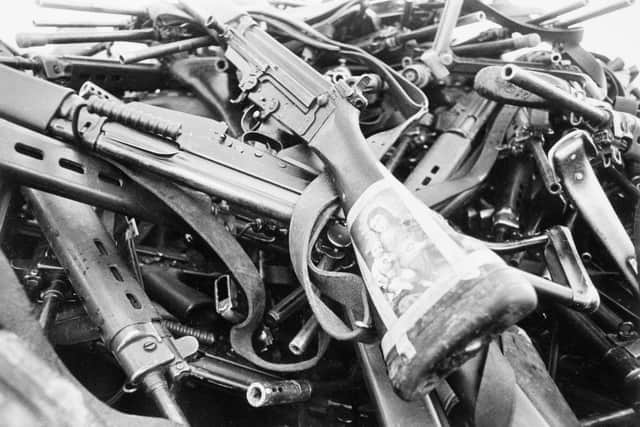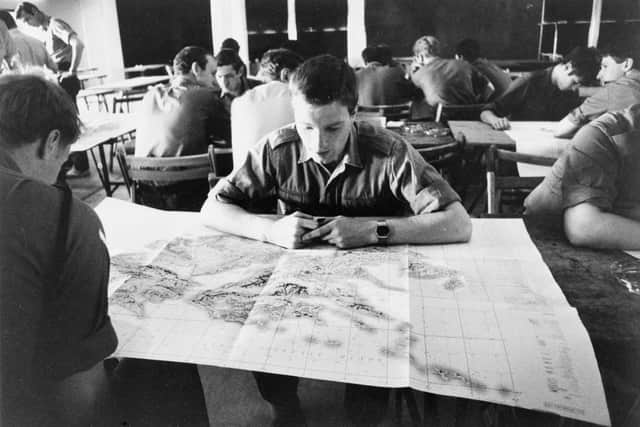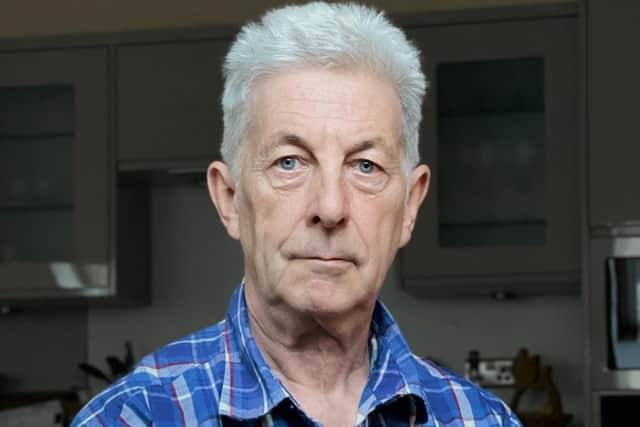The Yorkshire photographer who captured frontline images in the middle of Falklands War
PAUL Haley never imagined he’d be in the middle of a war. He was a civilian, not a soldier, and carried a camera, not a gun. Yet for a few tense weeks in 1982 he found himself in the thick of the ferocious fighting to recapture the Falkland Islands.
Paul was there to photograph the British forces trying to liberate the islands from their Argentinian invaders, and uniquely amongst the press covering the conflict, present at the personal request of the commanding officer of troops who fought – and died – in the climactic battles.
Advertisement
Hide AdAdvertisement
Hide AdNow Paul’s pictures are at the heart of the Imperial War Museum’s 40th anniversary exhibition about the war. At IWM North, in Salford, they are projected in the galleries as part of a large-scale display.


His photographs bring the brutal realities of the war fought 8,000 miles away from Britain vividly to life. They capture the strain on the soldiers’ faces, and the harshness of the wind-lashed, frozen moorlands and mountains in which they fought.
Paul, 71, from Morley, near Leeds, shared their privations and dangers, digging trenches to try to sleep in and being shelled by enemy artillery. And for a photographer, the conditions were especially difficult.
“I look back now and I don’t know how I did it, because it was so cold all the time,” he says. “Your feet were wet all the time. Keeping the cameras dry was just impossible, they just got wet.


Advertisement
Hide AdAdvertisement
Hide AdTrying to reload film and keep it dry was difficult, I had to unbutton my jacket and do it inside the jacket, but I could load them in the dark, because that was my job.”
His job was senior photographer at Soldier magazine, published by the Ministry of Defence, which he’d joined in 1971 after learning his craft taking wedding pictures in his native Colne Valley, and then serving an apprenticeship with a portrait photographer in Huddersfield.
When Argentina invaded the Falklands in April 1982 and Prime Minister Margaret Thatcher ordered a task force to the South Atlantic to reclaim them, Paul asked to sail with it. He was refused.
Instead, he went to Wales, to cover 5 Infantry Brigade training in readiness to fight in the Falklands. His pictures impressed its commander, Brigadier Tony Wilson, and Paul was ordered to Southampton, to board the liner Queen Elizabeth II, which was transporting thousands of soldiers to war.


Advertisement
Hide AdAdvertisement
Hide Ad“Tony Wilson had said he wanted me to go as part of 5 Brigade. As far as I know it was solely down to him,” says Paul. Brig Wilson, who died in 2019, made it clear he regarded Paul as one of the brigade’s own when the troops were preparing to land and fight.
“I said to Tony Wilson, ‘What happens to me now?’, and he said, ‘As far as I’m concerned you’re part of 5 Brigade, so you’re coming with us, if you want to’, and of course I wanted to.”
The QEII was held back from the war zone by the Government, fearful of a propaganda coup for Argentina if a ship bearing the Queen’s name was attacked and sunk, so the troops were transferred to another liner, Canberra, which landed them in the Falklands, at San Carlos Water, on June 2.
Paul says: “There was low cloud at first, which was brilliant because it meant less chance of air attack. I let two landing craft go, and photographed them. I got on the third one, and by that time it was proper daylight and the clouds started lifting. They say in the Falklands that if you wait long enough, you’ll get every season in one day and it really was like that.”
Advertisement
Hide AdAdvertisement
Hide AdPaul, going forward with the men of the Scots Guards, Welsh Guards and Gurkhas, quickly realised how harsh the weather could be. “Winds, really high winds. Even talking to people was difficult. Facing into the wind, it would catch your mouth and stop you talking.
“The things you can’t see in the photographs are how cold it was and how windy. The chances are that your feet were wet through with icy water, your legs were freezing cold.”
Paul had free rein to go where he thought best. “Once I’d landed, my aim was to get as far forward as I could. I was by myself, I’d drawn two days’ ration packs, so I tried to get forward. It was just a matter of finding out what was going on.”
Helicopter pilots helped by giving him lifts between the military units – and taking his films back to the ships moored in San Carlos to be developed and the pictures transmitted to Britain.
Advertisement
Hide AdAdvertisement
Hide AdPaul was not far away when the forces suffered their worst casualties of the war – 55 Welsh Guards killed, plus five naval crewmen, and more than 150 injured when their transport ships Sir Galahad and Sir Tristram were bombed in Fitzroy Sound on June 8.
He watched the attacking jets go in. “I was at Bluff Cove when the Argentinian jets came down and went round the corner and up to Fitzroy, and I’d never seen aircraft flying that low. They were just screaming down the valley, it was unreal. You could see the black smoke coming up over the hill.”
And he was there as troops went into battle on Mount Tumbledown, the high ground above the capital, Port Stanley, on the night of June 13. Eight Scots Guards were killed and 43 wounded taking the ground, the capture of which brought the war to an end with the Argentinian surrender the following day.
“I went forward with them onto Goat Ridge, which was their forming up area. We got shelled during the afternoon. It was tense, but it was exciting because I knew roughly what was going to go on.”
Advertisement
Hide AdAdvertisement
Hide AdPaul had such freedom that he was able to listen to the orders being given to the commanders of the troops who attacked Tumbledown. “It was really inspiring. He said, ‘Tell your men when they start going forward and it gets noisy, to keep walking and not to go down and hide, because if they go down, they’ll never get up so just keep walking through it’, and they did, it was incredible.”
Forty years on, Paul is honoured that the IWM is featuring his photographs and keen that more people should be aware of the bravery and sacrifice of those who fought for the Falklands.
Paul, who left Soldier magazine in 1987 to start his own photography business in Yorkshire, has twice been back to the Falklands with veterans. He maintains close friendships with many of the men he photographed in those bleak battlegrounds, and believes they deserve much greater recognition.
“They have been forgotten about. It’s the forgotten war, and the 40th anniversary isn’t a celebration, it’s a remembrance.
Advertisement
Hide AdAdvertisement
Hide Ad“I think it’s the war that wasn’t written much about, and it’s a shame. Post traumatic stress disorder wasn’t known about then, but a lot of soldiers have suffered from it, and are still suffering from it now, and that’s because nobody got the recognition they deserved for fighting a war.
“People say, ‘They gave their life’, but I don’t believe anybody gave their life. Most had it taken from them, and that’s the thing you’ve got to remember.”
- Paul Haley’s photographs are central to the IWM’s Falklands 40 exhibitions at its sites in London and Salford, which focus on eyewitness accounts of the conflict which claimed the lives of 255 British service personnel, 649 Argentinian and three civilian islanders.
- Many of his pictures have never been displayed before, and capture pivotal moments of the campaign, including landing crafts taking troops ashore and the aftermath, when huge piles of weapons were dumped by defeated Argentinian forces.
Advertisement
Hide AdAdvertisement
Hide Ad- Paul will be amongst 10,000 invited guests at the Falklands War 40th anniversary national commemoration, organised by the Royal British Legion, at the National Memorial Arboretum, in Staffordshire, on May 14.
